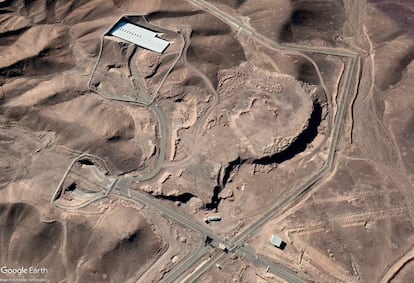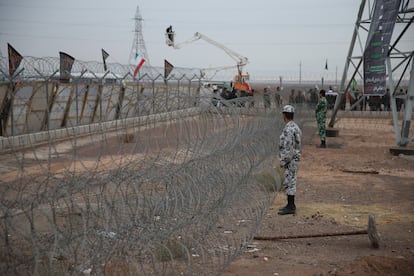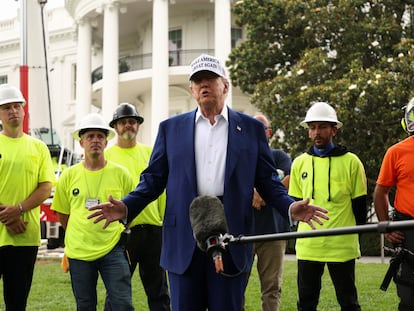The GBU-57, the only missile capable of destroying Iran’s best-protected nuclear plant
Only the ‘bunker-buster’ possessed by the US, capable of penetrating to a depth of 60 meters, could hit the Fordow uranium enrichment plant, essential to Iran’s atomic program

According to satellite photographs, the central part of the Fordow facility, one of the key complexes in Iran’s nuclear program, has not undergone major changes in the last 20 years. Located about 60 miles southwest of Tehran, near the holy city of Qom, behind a fenced perimeter Fordow encloses one of the best-preserved jewels of Iran’s uranium enrichment machinery, a priority target of Israel’s current military campaign. According to Israeli intelligence, Fordow’s centrifuges are about 80 meters underground. And there is only one weapon capable of penetrating to such a depth with enough force to cause damage. It weighs more than 13,600 kilograms (30,000 pounds), is in the possession of the United States, and is designated the GBU-57.
To date, Benjamin Netanyahu’s government has stated that the primary objective of its offensive against Iran is to destroy its nuclear program, although it has also mentioned the desire to overthrow the regime that supports it as a secondary objective. According to information provided by the Israeli military and corroborated by the International Atomic Energy Agency (IAEA), Israeli missiles have hit facilities such as Natanz, which was heavily damaged, Isfahan, and Arak, as well as the Fordow uranium fuel enrichment plant, although the impact in the latter case is not appreciable.

The IAEA confirmed in March 2023 that the Fordow centrifuges, capable of enriching uranium to levels of 60% — above what is required for civilian use — have reached 83.7%, already close to the 90% required to assemble a nuclear weapon. This is largely why the Fordow plant, located in the heart of a mountainous region in Iran, is one of Israel’s most coveted prizes. Netanyahu, however, does not have an effective weapon to disable it.
According to reports in the U.S. media over the past 48 hours, U.S. President Donald Trump and his defense advisors are discussing, first, U.S. involvement in the Israeli operation and, second, the possible use of the so-called “bunker-buster” to permanently bury the Fordow facility. The task is neither simple nor guaranteed to be entirely successful.
“Israel would either need U.S. support to destroy the facility or repeated airstrikes,” Heather Williams of the Center for Strategic and International Studies writes in an analysis, “but neither of these options guarantees that Fordow can be destroyed, which may require even stronger ordnance or sustained strikes.”
18 meters of concrete
Manufactured by the defense arm of the U.S. company Boeing and in service since 2011, the GBU-57, which is 6.2 meters long and capable of carrying 2,400 kilograms of explosive, can reach about 60 meters underground and can penetrate 18 meters of concrete. It has never been used in combat, much less for a target like the centrifuges at Fordow.
Its 13,600 kilograms of weight require the use of B-2 bombers, stealth aircraft designed in the late 1970s for missions that evaded enemy radar, and therefore, anti-aircraft munitions. According to satellite images obtained by Israeli intelligence, the Fordow complex is protected by artillery and missile launchers, both in the immediate vicinity and in the surrounding mountains.

If Washington gave the green light for an attack on Fordow, one of these B-2s, which can carry two GBU-57s, would fly over the area and drop the bomb at an altitude of over seven miles. It has no engine, so the speed it attains is the speed of its weight in free fall over the flight distance to the target. A GPS device allows the missile’s course to be modified via small wings on the tail. The kinetic energy associated with this powerful weapon multiplies the impact force, traveling a distance equivalent to a 20-story building before exploding.
The exact depth to which the Iranian regime has buried the Fordow plant is unknown. Satellite images, most of which were taken by Maxar Technologies, show that access to the facility is possible through at least six underground entrances on the north and northeast sides of the complex. Inside the fence, interrupted by a security checkpoint, a main building and a secondary building stand out at the edge of the compound, where there appears to be another underground access. A couple of thousand meters to the north, a polygon belonging to the uranium plant rises above ground.
The United States has about 20 B-2s stationed at Whiteman Airfield in Missouri. However, in late March, satellite company Planet Labs captured a snapshot of the U.S. base on Diego Garcia Island in the Indian Ocean, in which four of these aircraft and six support aircraft could be identified. Therefore, the U.S. Air Force may have deployed up to half a dozen B-2s to the area, capable of covering the distance to Iran.
Sign up for our weekly newsletter to get more English-language news coverage from EL PAÍS USA Edition
Tu suscripción se está usando en otro dispositivo
¿Quieres añadir otro usuario a tu suscripción?
Si continúas leyendo en este dispositivo, no se podrá leer en el otro.
FlechaTu suscripción se está usando en otro dispositivo y solo puedes acceder a EL PAÍS desde un dispositivo a la vez.
Si quieres compartir tu cuenta, cambia tu suscripción a la modalidad Premium, así podrás añadir otro usuario. Cada uno accederá con su propia cuenta de email, lo que os permitirá personalizar vuestra experiencia en EL PAÍS.
¿Tienes una suscripción de empresa? Accede aquí para contratar más cuentas.
En el caso de no saber quién está usando tu cuenta, te recomendamos cambiar tu contraseña aquí.
Si decides continuar compartiendo tu cuenta, este mensaje se mostrará en tu dispositivo y en el de la otra persona que está usando tu cuenta de forma indefinida, afectando a tu experiencia de lectura. Puedes consultar aquí los términos y condiciones de la suscripción digital.
More information
Archived In
Últimas noticias
Most viewed
- Sinaloa Cartel war is taking its toll on Los Chapitos
- Oona Chaplin: ‘I told James Cameron that I was living in a treehouse and starting a permaculture project with a friend’
- Reinhard Genzel, Nobel laureate in physics: ‘One-minute videos will never give you the truth’
- Why the price of coffee has skyrocketed: from Brazilian plantations to specialty coffee houses
- Silver prices are going crazy: This is what’s fueling the rally










































